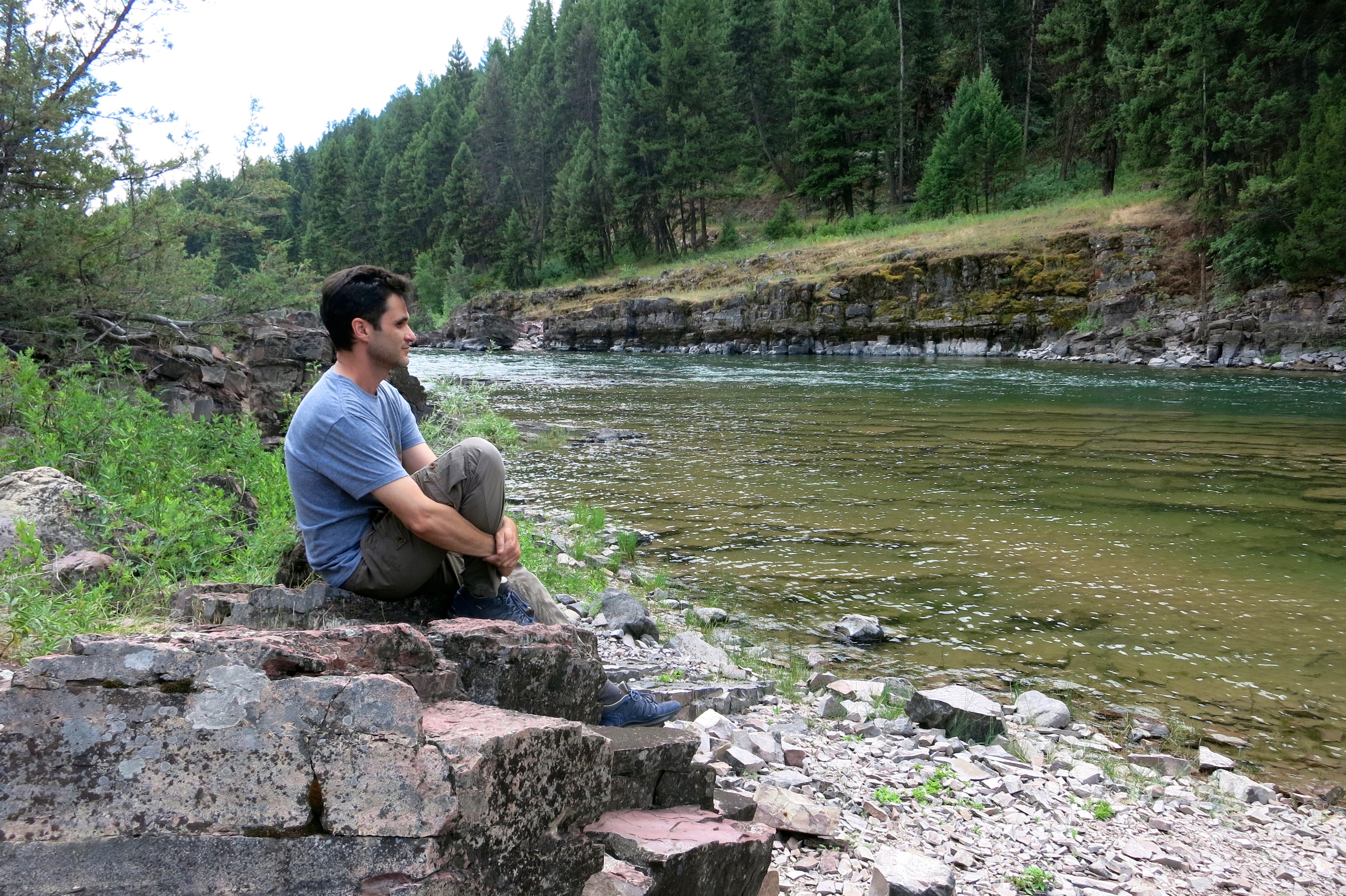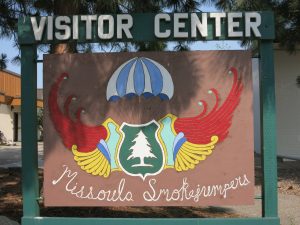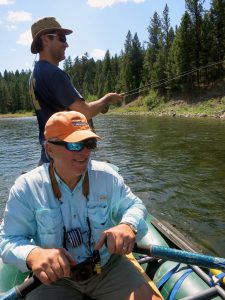
Twenty-five years ago, a story set in Montana made a star of Brad Pitt. That story, filmed by Robert Redford, was ‘A River Runs through It’, a mini masterpiece by Norman Maclean
The barman at Bayern Brewing hadn’t been expecting us, though his T-shirt suggested otherwise. On the front was an image of a cutthroat trout and the logo “WestSlope Chapter Trout Unlimited”. On the back, in black lettering against grey, were these words: “The world is full of bastards, the number increasing rapidly the farther one gets from Missoula, Montana.”The quotation is from “A River Runs through It” by Norman Maclean, a little story with a large reputation. It was July 2015, a festival dedicated to Maclean and his work was about to open, and two of us had come to collect a couple of kegs, donated by the brewery’s boss, to help lubricate the literary gathering. After all, “in Montana drinking beer does not count as drinking.”
That line is from the same book, A River Runs through It and other stories, which runs to only 217 pages in my well-thumbed Picador paperback edition but has something quotable on nearly every page. I first read it after its British publication in 1990 (it came out in the US in 1976), and was transported from the suburban sprawl of south London to the big skies of the Rockies. Its lead story, one of fly fishing and familial love, and of the impossibility of being your brother’s keeper when your brother is bent on self-destruction, was sensitively adapted by Robert Redford 25 years ago in a film that made a star of Brad Pitt. (The making of the film was explored in the second “Maclean Footsteps Festival”, held in Montana in September 2017. )
The book’s other two stories drew on Maclean’s experience in his youth in a logging camp and as a firefighter with the US Forest Service. They were stories of the west, suffused with the rhythms of poets Maclean had taught farther east. “I think poets have influenced me more than prose writers,” he told one interviewer, citing Wordsworth, Hopkins, Browning and Robert Frost, with whom he had taken a writing seminar while earning his BA at Dartmouth College. In 1922 he had entered the poetry competition of The Dial magazine in New York, which was won by TS Eliot. The judges weren’t unanimous: two chose The Waste Land, but one, Carl Sandburg (the man who made Chicago the “City of the Big Shoulders”), preferred a poem from Maclean.
He published only two books and a few essays. This was partly because he didn’t get going as an author until he reached his “threescore years and 10”, after a distinguished career as a literature professor at the University of Chicago; it was partly, too, because of a Presbyterian perfectionism instilled by his father, a Scot and a Presbyterian minister, whose idea of home-schooling was to set his son a composition, then order him to cut it by half and by half again. Maclean died in 1990, without seeing Redford’s film and before finishing a second book, about a forest fire that had killed 13 of 16 firefighters in Mann Gulch, Montana, in 1949. It was published, as Young Men and Fire, in 1992.
Until two years ago, I had read only an excerpt from Young Men and Fire, but I had read A River Runs through It four or five times, and pressed it on other readers. I had recommended it, too, to would-be writers, for the lessons it offers in making every word count. As soon as I heard of plans for the first “Maclean Footsteps” festival, at Seeley Lake, where the writer’s family has long had a summer cabin, I booked my place. But first I flew in to Missoula (pronounced “Mizzoula”), between Glacier National Park and Yellowstone Park, where the story started.
Norman Maclean was born in 1902 in Clarinda, Iowa, but moved in his sixth year with his family to Missoula, where his father, John, had been appointed pastor at the First Presbyterian Church. It was then a timber town where cowboys were “ranch hands” and “Indians” still pitched teepees in summer along the Clark Fork River. These days the cowboys are outnumbered by hippies (Missoula, home to the University of Montana, has a reputation as the state’s most liberal town) and the banks of the Clark Fork are lined by kayakers awaiting their turn on an artificial wave.
The church the Reverend Maclean first preached at is gone, replaced by a towering building in red brick. Outside is a grey stone plaque etched with an image of a fisherman up to his knees in a river, mountains rising behind. The inscription says: “In memory of Dr John Norman Maclean, pastor of First Presbyterian Church from 1909 to 1925, whose love of God, family and creation inspired the story ‘A River Runs through It…’.” That story, a fictionalised memoir, tells how the Reverend Maclean made anglers of his sons (“In our family, there was no clear line between religion and fly fishing”), and how the younger one, Paul, an artist on the river but a gambler and street-fighter in town, came to a bad end at the age of 33: beaten to death in an alley with the butt of a revolver.
Paul is buried with his parents in Missoula cemetery under a simple two-tier stone. Sprinklers played in high arches over the grass as I walked along the rows to see it, under a Montana sky that was as big as I had expected, but hazier. Mary Holmes of Destination Missoula put me right: it wasn’t haze; it was smoke from forest fires in Idaho.
We heard more about those at the Smokejumper Visitor Centre, on the edge of town. Smokejumpers are parachuted into remote areas to suppress small fires started by lightning and fight more extensive ones. Of the 65 based in Missoula, 60 were out on jobs, some as far away as California. We saw the tools of their trade, the manufacturing room where they sew their own suits and harnesses, the tower where their chutes hang, and the lockers or, rather, cages, where, when they get a call, they drop everything that’s not essential to firefighting: MP3 players, house keys, family snapshots.
One room, a mock-up of a fire lookout tower, had a bed that Norman Maclean would collapse on to after a day’s writing in the cabin at Seeley Lake. A caption signed by his son, John (also a writer), pointed out that it had no box spring, so cold air came straight into it. “Maclean at first put a layer of newspapers under the mattress. It didn’t help much — the cabin is heated by a single stove — and eventually he added an electric blanket. The bed was donated to the Missoula Smokejumpers, memorialised in Maclean’s Young Men and Fire,… when it was finally replaced, in 2005.”

Michael Cropper, whom I’d helped to pick up the beer kegs, drove me the 50 miles or so to Seeley Lake, alongside dense forests, high mountains and a chain of glacial lakes. En route, we passed the high-rise accommodation of some regular fishing tourists: ospreys, up from Mexico to nest on poles in the Seeley-Swan Valley.
Michael, a sprightly Englishman in his eighties, and his partner, Sara Wilcox, who met on a sailing trip, sold their boat and built a cabin on a hill overlooking Seeley Lake. It’s a little town (population: 1,659) but a literate one: Sara, who runs its book club, said a talk by a writer can draw close to 100 people in the winter. The festival was her idea, and she roped in as co-ordinator her friend Jenny Rohrer, who, being a film-maker, knows how to raise funds. Between them, they signed up as speakers members of Maclean’s family, academics and editors, the novelist Pete Dexter — author of Paris Trout — and the governor of Montana, Steve Bullock.
Dexter had written a profile of Maclean for Esquire magazine in 1981. He told the gathering: “I was just really starting to be a writer at that point and I’d read A River Runs through It and wanted to be the guy that wrote that. I still do… I wasn’t copying Norman’s words or anything, but I was trying to compete — not to be him, just so he would like me.”
“Part of the power of Norman Maclean,” the governor said, “is that he reminded us that place is important, not just in a practical way but in a deeply grounding and often magical way. For those of us who call Montana home, the landscape is as much a part of our identity as is our family, our profession or our faith.” He touched, too, on the inspiration Maclean had given both conservationists and writers, and the contribution A River Runs through It had made and was making to tourism. Montana, a state of a million people, draws 11 million visitors a year, who add $4 billion to its economy. He said it was hard to quantify Maclean’s role in that, but he noted that what he called the fly-fishing “industry” grew by 60 per cent the year the film came out, and by another 60 per cent the following year.
Maclean wouldn’t necessarily have seen that as a blessing. In a letter in 1976, he complained of the Big Blackfoot river: “…there are so damn many fishermen on it now you have to bring your own rock with you”.
The festival featured both talks and walks. There was a trek to Mann Gulch (which I didn’t have time to join) and an outing to some of Maclean’s favourite fishing holes. On the latter, we filled a yellow school bus, and I was reminded of John Steinbeck’s warning that “two or more people disturb the ecologic complex of an area”. If we were a crowd, we were a respectful one, intent on on-the-spot readings from A River… by our guide, Jerry O’Connell, and occasional contributions from Noah Scot Snyder, Maclean’s 40-year-old grandson.
Jerry, a fly fisherman since childhood, is founder of the Big Blackfoot Riverkeeper, which aims to save the river from “being loved to death”. He fell for the Blackfoot Valley while hitch-hiking through Montana in 1986 and moved there from New England six years later. He has engraved on his wedding ring the penultimate line of “A River Runs through It” (“Under the rocks are the words, and some of the words are theirs”, with “theirs” changed to “ours”), but he hasn’t gone quite so far as a fisherman he knows in Sweden, who has tattooed on his back, in gothic lettering, the final line: “I am haunted by waters.”
Noah, a producer, mixer and engineer of film scores and albums (he won a Grammy in 2003 for his work with the singer-songwriter Warren Zevon), is now based in Los Angeles but escapes when he can to Montana. Our final stop was one where he remembered being taken by his grandfather. Places mingled in his memory, he said, but he was sure of this one, partly because of a distinctive layering of rocks, like stacked slates, a few yards from shore.
In readiness for the festival, I’d been briefing myself with the excellent The Norman Maclean Reader, edited by O Alan Weltzien, who was one of the speakers over the weekend. In a letter Weltzien includes, Maclean tells how his written stories emerged from the ones he used to tell his children and his western pals: “Even your children or your pals aren’t going to listen to you for more than 10 or 15 minutes, so there is great premium on deletion, and especially of all scenery. Besides, they know the scenery. All you have to say is ‘the Blackfoot river’.”
How, then, did Maclean manage to transport me, and so many others who had yet to see that scenery, all the way to Montana? I’m reminded of advice a writer friend of mine was given by the great London publisher Jock Murray: “Cut, and an echo of what you have cut will remain.”
In “A River Runs through It”, Maclean tells how his father instructed him to cast on a four-count rhythm, sounded out by a metronome. Noah had it easier. He was allowed initially to use a spinning rod rather than a fly rod, but there had to be a lure on the line. “Even if we were going to break this sacrament of fly fishing we still had to observe certain rules. We couldn’t use bait — that was not gonna happen.”
Noah is now an accomplished fly fisherman, as I saw next day when Jerry took both of us out in an inflatable on the river. At our starting point at Corrick’s River Bend, the Big Blackfoot was a tricolour landscape: rounded grey stones on the shore, grey-green willows above them, and then, arrowing darkly heavenwards, forests of pine, fir and western larch. Within 15 minutes, Noah had hooked the first of a series of tiddlers, among them a cutthroat and a brown trout. “I’m only catching fish that haven’t been around long enough to know the difference between a real bug and a man-made one,” he joked.

A couple of hours in, he got another bite, a bigger fish. Jerry nodded approvingly as Noah reeled in: “That’s a hell of a nice fish — a 16-inch cuttie.” Just as Noah was about to take it from the water, though, it slipped off the hook. While Noah cast, Jerry educated and entertained (“I can get a fly tied in a minute — but it does end up looking like a love-seat shot with a goose gun”). He filled me in on the way in which the river was being damaged by logging, mining and grazing before Redford’s film — so much so that most footage of fishing was shot elsewhere in Montana. Since then, the Nature Conservancy, working with local groups, has bought up land in a series of parcels, most recently adding a ridgeline that is one of the finest habitats for wolverine and grizzly bears in the United States. “So we’re now surrounded by protected land. It’s phenomenal.”
I’d only ever fished with spinners or bait, and Jerry reckoned it was “time to get that fly-fishing virginity smell off you”. My first cast, predictably, fell in front of me. The Compleat Tangler. When I tried again, the line barely lifted off the water. Jerry spotted the problem: the rod had snapped a couple of feet from the tip. It was nothing I’d done, he said; there might have been a weakness there, something waiting to go, and the rod was under lifetime guarantee. Still, I felt guilty, and I had nothing to fish with.
There were compensations: beaver dams, a mink scurrying through the bankside brush, and the call of what Jerry told me was a bald eagle. For such a powerful bird it was surprisingly dainty: a series of high-pitched piping notes. I could understand why film-makers were in the habit of overdubbing it with the more muscular cry of the red-tailed hawk.
I could understand, too, what had made Jerry up sticks from New England, and why Norman Maclean, who decided he couldn’t live in Montana if he was to fulfil his potential as a teacher, found his wellspring there as a writer. I thought of a poem he had written after the publication of A River Runs through It:
FOREVER
Loneliness is not always lonely.
It can go on to ecstasy.
When I am alone in the woods I am the universe.
What is there
I do not know
Or cannot do?
Do not tell me I cannot live forever.
I already have.
MK
- My trip to Montana was arranged by The Ultimate Travel Company (0203 733 5715; theultimatetravelcompany.co.uk) and the Montana Office of Tourism (visitmt.com).
- Further reading: A River Runs through It and other stories; Young Men and Fire; The Norman Maclean Reader, edited by O Alan Weltzien (all published by University of Chicago Press).
- A shorter version of this article appeared in the TLS on September 1, 2017.
